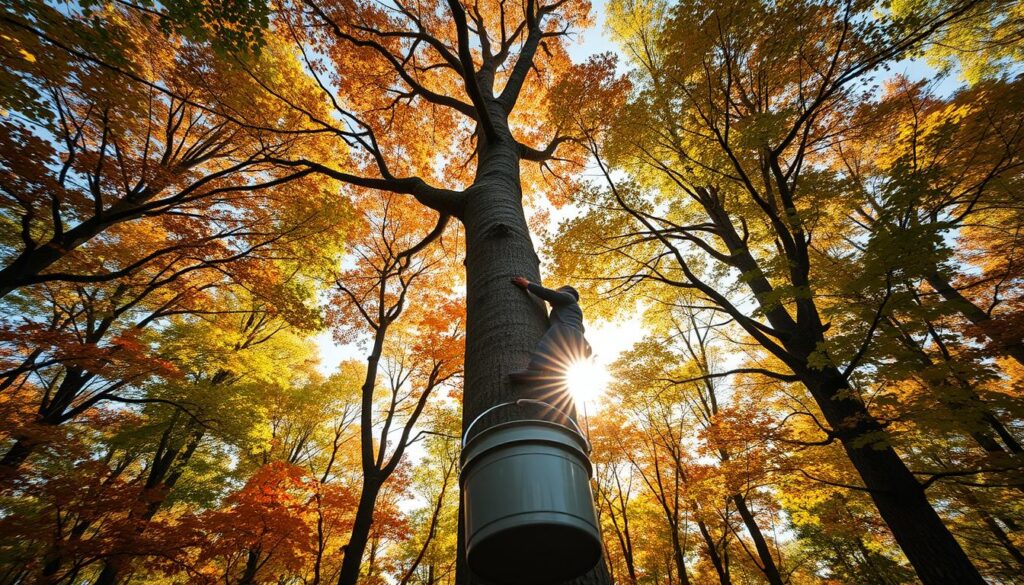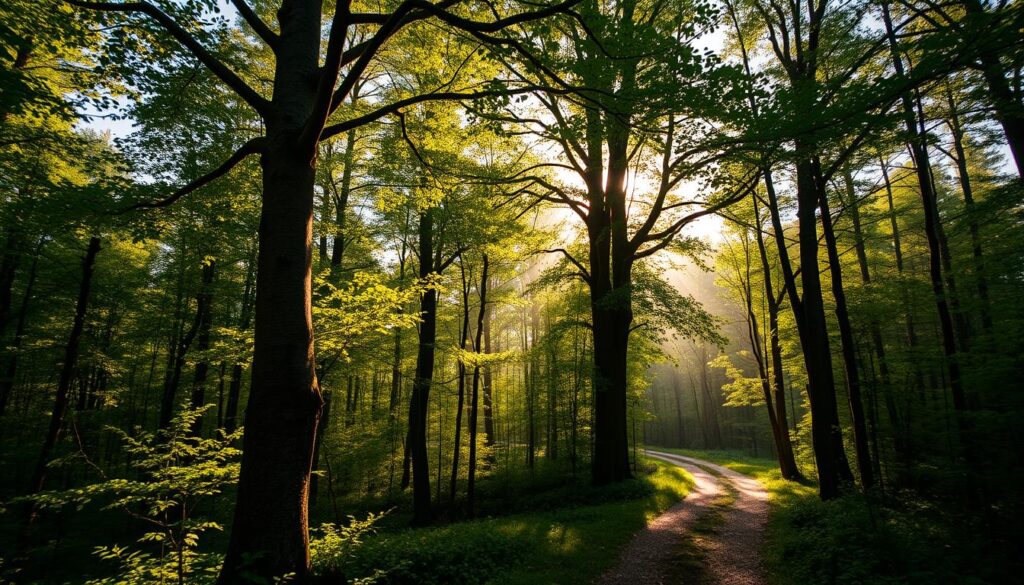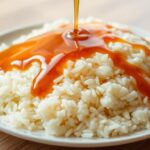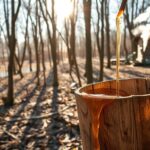Maple syrup trees are amazing natural wonders. They turn simple tree sap into golden liquid. These trees, like the sugar maple, are heroes in North American forests. They make one of the most loved natural sweeteners.
Maple syrup trees have incredible stories. In late winter and early spring, they start a special process. This process fascinates food lovers and nature fans. The sugar maple tree makes the richest, most flavorful syrup.
Maple syrup making is more than a tradition. It’s a mix of nature and human skill. Sugarmakers pick and tap trees carefully. They know the sap flow depends on the right mix of cold nights and warm days.
Maple syrup trees are special in the northeastern U.S. and Canada. Native communities first found their sweet value. They learned to extract and process sap long before Europeans came.
Maple syrup is loved worldwide, from pancakes to fancy dishes. The path from tree to table shows nature’s amazing work. It makes this unique, rich sweetener.
The Rich Heritage of Maple Syrup Production
Maple syrup production is a fascinating journey through North American history. It starts with indigenous communities who first made syrup from maple tree sap. This sweet treasure has a long and rich history.
Native American Origins and Colonial Adoption
Native American tribes were the first to make maple syrup. They used clever ways to collect and process sap before European settlers came. Their methods included:
- Identifying sugar maple trees
- Making V-shaped cuts in tree bark
- Collecting sap in wooden containers
- Boiling sap using heated stones
Evolution of Syrup-Making Techniques
With European colonization, syrup-making changed a lot. Settlers brought metal tools and better boiling methods. These changes made maple syrup production much more efficient.
| Era | Syrup-Making Technique | Key Innovation |
|---|---|---|
| Native American Period | Stone boiling method | Wooden tools |
| Colonial Period | Iron pot boiling | Metal spouts and buckets |
| Modern Era | Vacuum-assisted collection | High-efficiency evaporators |
Cultural Significance in North America
Maple syrup production is more than just making food. It shows a deep connection to the land, tradition, and nature’s cycles. Communities in Canada and the northeastern United States celebrate this tradition. They keep alive a legacy that spans many generations.
Understanding the Maple Syrup Tree Species
The world of maple syrup is all about certain tree species. The sugar maple tree is the top choice for sap. These trees, found in the northeastern U.S. and southeastern Canada, have special traits for making syrup.
Not every maple tree is good for syrup. The sugar maple tree stands out because of its high sugar sap, strong bark, and perfect growing conditions. It also has sap that flows well with the seasons.
- High sugar content in sap
- Robust bark and strong trunk structure
- Optimal growing conditions in cooler climates
- Consistent sap flow during seasonal temperature changes
While sugar maples are the main syrup makers, other trees like red maples and black maples can also help. But their sap has less sugar.
Where trees grow is key for syrup making. The best trees are in places with cold winters and mild springs. This is where they make the most sap.
Knowing about maple trees helps sugarmakers pick the best ones. The sugar maple’s special traits make it the best for syrup.
The Science Behind Sap Production
Maple tree sap production is a fascinating natural phenomenon. It’s driven by complex biological processes. The maple syrup season is a delicate dance between temperature, tree physiology, and environmental conditions.
Maple trees have a unique ability to store and transport nutrients. During the maple syrup season, they undergo remarkable transformations. These changes enable sap collection.
Seasonal Temperature Dynamics
Temperature is key in maple tree sap production. The ideal conditions happen when nighttime temperatures drop below freezing. Daytime temperatures need to rise above 40°F.
This temperature fluctuation creates pressure changes in the tree. These changes trigger sap movement.
- Nighttime temperatures below 32°F cause tree tissues to contract
- Daytime temperatures above 40°F create expansion
- Pressure differences force maple tree sap to flow
Chemical Composition of Maple Sap
Maple sap is more than just sugar water. It contains a complex mixture of minerals, organic acids, and nutrients that give it a unique flavor.
| Component | Percentage |
|---|---|
| Water | 97-99% |
| Sugar | 2-3% |
| Minerals | 0.5-1% |
Environmental Factors Affecting Sap Flow
Several environmental elements influence maple tree sap production. Soil health, tree age, and the overall forest ecosystem impact sap quality and quantity.
- Soil pH levels
- Tree diameter and age
- Forest canopy density
- Regional climate patterns
Understanding these scientific principles helps sugarmakers optimize maple sap collection. This leads to producing high-quality maple syrup.
Identifying Prime Sugar Maple Trees for Tapping
Choosing the right sugar maple tree is key for making maple syrup. Not all maple trees are good for tapping. Knowing the right characteristics helps get more sap and keeps the tree healthy.
When picking sugar maple trees for tapping, several important factors matter. The tree’s age and size are critical. Trees should be about 10 inches in diameter at chest height to be ready for tapping. Trees that are too young or small might get damaged easily.
- Look for trees with a healthy, robust trunk
- Check for a well-developed crown with extensive branch spread
- Assess the overall tree vigor and absence of significant damage
- Verify the tree is at least 40 years old
Experienced maple syrup makers stress the importance of choosing the right trees. The health of the tree affects sap production and the forest’s future.
Good signs of a great sugar maple tree include:
- Smooth, light gray bark with minimal scarring
- Dense, symmetrical branch structure
- No signs of disease or pest infestation
- Strong root system visible through surface roots
Experts usually tap only healthy, mature trees to avoid harm. A well-chosen sugar maple can give sap for many years if tapped carefully.
Essential Tools for Maple Syrup Harvesting
Maple syrup tapping needs a special set of tools. These tools mix old ways with new tech. Sugarmakers use this equipment to get syrup efficiently.
Traditional vs Modern Tapping Equipment
The tools for tapping maple syrup have changed a lot. Old days used simple things like:
- Wooden spiles
- Metal buckets
- Hand drills
Now, we have new tech for tapping maple syrup:
- Plastic tubing systems
- Automated vacuum collection
- Precision drilling equipment
Storage and Processing Tools
Keeping syrup quality is key. Important tools for this are:
- Stainless steel collection tanks
- Reverse osmosis machines
- High-efficiency evaporators
- Advanced filtering systems
Safety Equipment Requirements
Harvesting syrup safely is important. Sugarmakers wear special gear to stay safe:
- Insulated waterproof boots
- Heavy-duty work gloves
- Safety glasses
- Protective headwear
Every tool is vital for making syrup from sap. It shows how tradition meets modern tech.
When to Start Tapping: Timing the Maple Season
The maple syrup season is a delicate dance between nature and timing. To tap maple trees successfully, you need to know the exact environmental conditions for the best sap flow.

Maple tree tapping happens in late winter and early spring. This is when the temperature is just right for sap to move. Sugarmakers wait for nights that freeze and days that warm up.
- Ideal temperature range: 20-40°F (-6 to 4°C)
- Typical season duration: 4-6 weeks
- Peak collection period: Late February to early April
Where you are affects the maple syrup season. Places like Vermont and New Hampshire get longer, steadier sap flows. This is different from the south.
| Region | Typical Tapping Start | Season Length |
|---|---|---|
| Northeast | Late February | 6 weeks |
| Midwest | Early March | 4-5 weeks |
| Southeast | Mid-March | 3-4 weeks |
“The secret to great maple syrup is patience and understanding the subtle signals of the forest.” – Traditional Sugarmaker’s Wisdom
Climate change is changing when we tap maple trees. Now, sugarmakers use new ways to track the weather. This helps them collect sap even when the season is unpredictable.
The Step-by-Step Maple Tree Tapping Process
Tapping maple trees is a precise art that has been passed down for generations. It turns a simple tree into a source of liquid gold. The process starts with picking the right tree and ends with a sweet harvest.
Success in maple syrup tapping comes from knowing each step well. From picking the right tree to collecting sap, every detail is important. This makes the natural sweetener we all love.
Proper Drilling Techniques
Drilling into maple trees needs precision and care. Sugarmakers follow specific rules to avoid harming the tree:
- Select healthy trees with a diameter of at least 10 inches
- Use a clean, sharp drill bit between 7/16 and 5/16 inches
- Drill at a slight upward angle to facilitate sap flow
- Create holes 1.5 to 2 inches deep into the tree
Spout Installation Methods
Choosing the right spout is key for good sap collection. Different methods can affect how well sap is collected:
| Spout Type | Advantages | Typical Use |
|---|---|---|
| Traditional Metal Spouts | Durable, long-lasting | Small-scale production |
| Plastic Spouts | Lightweight, affordable | Large commercial operations |
| Plastic Tubing Spouts | Efficient sap collection | Modern maple syrup farms |
Collection System Setup
Good sap collection is at the heart of maple syrup making. Modern sugarmakers use two main methods:
- Bucket System: Traditional method using hanging buckets
- Tubing Network: Advanced system connecting multiple trees
“The art of tapping maple trees is a dance between human skill and nature’s generosity.” – Traditional Sugarmaker
Modern Maple Syrup Production Methods
Maple syrup production has seen big changes in recent years. Old ways of collecting and processing sap are now replaced by new methods. These changes make the process more efficient and increase the amount of syrup made.
Today, maple syrup makers use advanced technology to make their work easier. Some of the key innovations include:
- Reverse osmosis systems for faster sap concentration
- High-efficiency vacuum pumps for increased sap extraction
- Digital monitoring equipment for precise temperature control
- Automated evaporators with enhanced heat exchange capabilities
These modern methods help sugarmakers make syrup more accurately and with less effort. Even small producers can use smaller versions of these technologies to boost their syrup-making skills.
| Technology | Efficiency Improvement | Cost Reduction |
|---|---|---|
| Reverse Osmosis | 40-50% faster sap processing | Reduces fuel consumption |
| Vacuum Pump Systems | 25-35% increased sap yield | Minimizes manual collection labor |
| Digital Monitoring | Precise temperature tracking | Reduces product quality variations |
Even as technology keeps getting better, the heart of maple syrup making stays true to tradition. New methods just make this ancient craft more efficient.
Sustainable Practices in Maple Tree Management

Keeping sugar maple tree forests healthy is key. Sugarmakers know that protecting these forests is vital. It ensures maple syrup production for future generations.
Sustainable forest management looks at the big picture. It involves careful planning and strategic actions. These steps help keep the balance in these special forest ecosystems.
Forest Conservation Strategies
Conserving sugar maple tree forests requires several important steps:
- Using selective harvesting techniques
- Protecting biodiversity in maple forests
- Keeping soil healthy through management
- Checking tree density and forest mix
Long-term Tree Health Maintenance
Keeping maple syrup trees healthy needs proactive steps:
- Practicing responsible tapping
- Preventing pests and diseases
- Adapting to climate changes
- Doing regular forest health checks
Climate resilience is key for sugar maple tree survival. Sugarmakers must prepare for environmental changes. They need to use management techniques that protect these forests.
The future of maple syrup production depends on our commitment to sustainable forest management today.
Processing Raw Sap into Pure Maple Syrup
The syrup-making process turns raw maple sap into a tasty golden liquid. Sugarmakers extract sap from maple trees during a short season. This is when sap flows the most.
To make maple syrup, you need to know a few key steps:
- Collect fresh sap right away
- Filter out debris and natural impurities
- Start the concentration process with precise heating
- Keep an eye on sugar content and consistency
The concentration process removes water through evaporation. Maple syrup makers use special evaporators. They heat the sap to about 219 degrees Fahrenheit. This important temperature turns thin sap into rich syrup.
“Maple syrup production is part science, part art – requiring patience and precision.” – Vermont Maple Sugar Makers Association
Skilled sugarmakers know that controlling temperature is key to syrup quality. They use special tools to check the liquid’s density. It takes about 40 gallons of sap to make one gallon of syrup.
The last step is filtering and bottling. This makes sure every drop meets high quality standards. These standards are set by maple syrup makers in North America.
Grading and Quality Standards for Maple Syrup
Maple syrup production has a detailed grading system. It helps people know the quality and taste of their favorite sweetener. This process makes sure each bottle is pure and flavorful.
The USDA has a grading system for maple syrup. It sorts syrup by color and taste. This system helps both makers and buyers see the differences in maple syrup.
Color Classification System
Maple syrup grades are based on color and light. They range from golden to very dark. Each grade has its own special qualities:
- Golden Color (Delicate Taste): Lightest grade, made early in the season
- Amber Color (Rich Taste): Slightly darker, with a stronger maple flavor
- Dark Color (Robust Taste): Deep amber, with a bold maple taste
- Very Dark Color (Strong Taste): Darkest grade, with the strongest flavor
Taste Profile Categories
Each maple syrup grade has its own taste. The flavor changes with the season and the trees.
Early syrups are lighter and sweeter. Late syrups are richer and more intense. Sugarmakers watch these changes to make top-quality syrup.
“The beauty of maple syrup lies in its subtle yet complex flavor variations.” – Maple Syrup Experts Association
Storage and Preservation Techniques

Keeping maple syrup fresh is key. The right storage methods can make it last longer and keep its special taste.
Choosing the right container is important. Glass or food-grade plastic is best. Make sure the lid fits tightly to keep it clean.
- Store unopened maple syrup in a cool, dark place
- Refrigerate after opening to prevent spoilage
- Keep away from direct sunlight and heat sources
Keeping the syrup at the right temperature is vital. It should be between 32-40°F (0-4°C). Refrigeration stops mold and keeps the syrup perfect.
Watch for signs of spoilage:
- Visible mold growth
- Off-putting smell
- Unusual color changes
- Crystallization or sugar formation
To keep syrup for a long time, freezing is a good option. Frozen syrup can last up to a year. Always use clean tools to avoid contamination.
Pro tip: Always label your maple syrup containers with the harvest date to track freshness and quality.
Health Benefits and Nutritional Value
Maple syrup trees are more than just a tasty sweetener. They offer a wealth of nutritional benefits that make them stand out from other sweeteners.
Maple syrup is a natural sweetener that’s different from refined sugars. It has compounds that are good for you, unlike processed sweeteners.
Essential Minerals and Antioxidants
Maple syrup is full of important nutrients:
- Zinc: Supports immune function
- Manganese: Aids bone health and metabolism
- Calcium: Promotes strong bones and teeth
- Potassium: Helps regulate heart function
The antioxidants in maple syrup are impressive. Research suggests they can protect cells from damage. This may help reduce inflammation and support health.
Comparison with Other Sweeteners
Maple syrup has unique nutritional benefits compared to other sweeteners:
| Sweetener | Mineral Content | Antioxidant Levels |
|---|---|---|
| White Sugar | Minimal | None |
| Maple Syrup | High | Significant |
| Honey | Moderate | Moderate |
Even though maple syrup is sweet, it’s a better choice than other sweeteners. Its natural origin and nutrients make it a healthier option.
Commercial vs. Backyard Maple Syrup Production
Maple syrup production is for both hobbyists and professionals. It ranges from small backyard setups to big commercial operations. Each has its own special features and challenges.
For those who love the traditional syrup-making craft, small-scale production is perfect. Backyard producers usually handle:
- 5-20 maple trees
- Manual tapping techniques
- Small-batch processing
- Limited annual yield
On the other hand, commercial maple syrup production is a big deal. It involves using the latest technology and careful forest management.
| Production Aspect | Backyard Production | Commercial Production |
|---|---|---|
| Number of Trees | 5-20 trees | 500-5,000 trees |
| Annual Syrup Yield | 1-5 gallons | 500-10,000 gallons |
| Equipment Investment | $500-$2,000 | $50,000-$500,000 |
To make maple syrup well, you need to know about local forests, climate, and tree care. Whether it’s a hobby or a job, hard work and knowledge are key to making great syrup.
“Maple syrup production is both an art and a science, connecting people with nature’s sweet side.” – Vermont Maple Sugar Makers Association
New maple syrup producers should start small. Learn the basics and grow your operation as you gain experience and meet demand.
Conclusion
Maple syrup is a blend of nature’s wonder and human creativity. It starts with Native American traditions and moves to today’s sustainable forestry. Every drop of maple syrup shares a tale of patience, precision, and respect for nature.
Maple Syrup Tree farming is more than just growing food. It’s a mix of caring for the environment and creating delicious food. Sugarmakers in North America use old methods and new tech to make this sweetener special. They keep it a key part of local culture and economy.
Maple syrup is gaining popularity for its authentic taste and story. Making it involves skill, knowing the forest, and connecting with the seasons. It’s loved in fancy dishes, as a natural sweetener, and as a symbol of local heritage.
Learning about maple syrup’s journey from tree to table deepens our respect for it. By choosing maple syrup from responsible makers, we help keep traditions alive and protect forests for the future.



